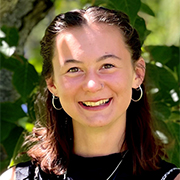Analysis of radiocarbon dates on Terminal Pleistocene horses from North America shows synchronous local extirpation and overlap with Paleoindian technocomplexes

Larkin Chapman, MS, PhD Student
Anthropology
Mentors: Emily Jones and Bruce B. Huckell
Absolute dating in archaeology is dominated by radiocarbon dating, a method which is frequently conducted on zooarchaeological material, creating a large and diverse global dataset that is readily accessible.
When aggregated, radiocarbon dates can also contribute to answering big archaeological questions; for example, debates over North American Pleistocene extinctions. I use data from published works and the Canadian Radiocarbon Database to show that there is good evidence that Pleistocene horses and recognized Paleoindian peoples shared the landscape in North America for a substantial period of time.
This has considerable implications for our understanding of regional megafaunal extinctions, Paleoindian diet breadth, and horse evolutionary history. By using data produced by multi-disciplinary communities and focusing on one taxon, this project uses a complex zooarchaeological dataset to address questions that have permeated generations of researchers.
